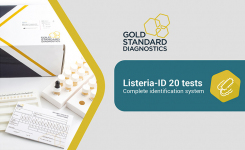"With the BC-S test, clinicians diagnosing patients suspected of deadly infections have a rapid, accurate molecular diagnostic tool which can differentiate two important disease-causing Staphylococcus bacteria, while simultaneously determining antibiotic resistance within the critical timeframe for making and adjusting initial treatment decisions.," said Nanosphere CEO Bill Moffitt. "With this clearance we continue expansion of our product offering, enabling microbiologists to replace century-old methods with rapid, accurate molecular diagnostic tests," he added.
In a single automated test, the Verigene BC-S test provides detection of Staphylococcus aureus, Staphylococcus epidermidis, and the mecA gene. The mecA gene confers resistance to the antibiotic methicillin/oxacillin. Methicillin-resistant Staphylococcus aureus (MRSA) bacteremia is associated with a significantly higher mortality rate than methicillin-susceptible Staphylococcus aureus bacteremia, posing a substantial healthcare burden.1
The BC-S test provides species and resistance detection from two types of gram-positive blood culture bottles within two and a half hours, as compared with current microbiological culture methods, which can take up to 3 days. Identification of bacteria and resistance markers is critical in guiding appropriate antibiotic treatment. Studies have shown that delayed administration of appropriate antibiotics is associated with a 7.6% decrease in survival rate for each hour that therapy is delayed.2 Rapid molecular testing of blood cultures has been shown to reduce this time, and is associated with hospital cost savings of up to $21,000 per patient.3
The sample-to-result BC-S test automates the steps of bacterial nucleic acid extraction and target detection on the Verigene System. The ease-of-use and rapid turnaround time of the BC-S test allow hospitals of any size to benefit from the speed and accuracy of automated molecular testing.
References: 1. Wang FD, Chen YY, Chen TL, Liu CY. Risk factors and mortality in patients with nosocomial Staphylococcus aureus bacteremia. Am J Infect Control. 2008;36(2):118-22.
2. Kumar A, Roberts D, Wood KE. Duration of hypotension before initiation of effective antimicrobial therapy is the critical determinant of survival in human septic shock. Crit Care Med. 2006;34(6):1589-1596.
3. Bauer KA, West JE, Balada-Llasat J, Pancholi P, Stevenson KB, Goff DA. An antimicrobial stewardship program’s impact with rapid polymerase chain reaction methicillin-resistant Staphylococcus aureus/S. aureus blood culture test in patients with S. aureus bacteremia. Clin Infect Dis. 2010;51(9):1074-80.























